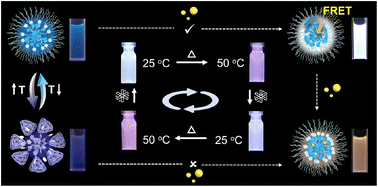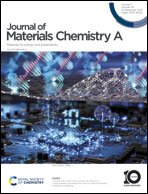A temperature-responsive artificial light-harvesting system in water with tunable white-light emission†
Abstract
Tunable photoluminescent materials have attracted great attention in the past decade. In the meantime, the light harvesting phenomenon in natural photosynthesis has greatly inspired the creation of luminescent materials. However, the environmental response properties of natural systems are less well modeled in this research field. In this study, we designed and synthesized a tadpole-type amphiphilic monomer (M), which contains a cyanostilbene group as the hydrophobic segment and oligo(ethylene glycol) (OEG) chains as the hydrophilic segment. M can self-assemble into nanoparticles in pure water due to its amphiphilicity. These nanoassemblies not only show tunable lower critical solution temperature (LCST) behavior but also exhibit temperature-responsive fluorescence. By co-assembling the hydrophobic dye DBT (energy acceptor) into M (antenna/energy donor) nanoparticles, an efficient artificial light-harvesting system with tunable fluorescence and temperature-responsive properties was constructed. Interestingly, white light emission can be achieved by incorporation of 1.67% acceptor at room temperature, which turns light purple at high temperature. This process can be repeated in heating/cooling cycles, reminiscent of the high-temperature inhibiting properties of natural photosynthesis. This work not only demonstrates a biomimetic stimuli-responsive light-harvesting system, but also provides a new idea for creating tunable luminescent materials in the pure aqueous phase.



 Please wait while we load your content...
Please wait while we load your content...